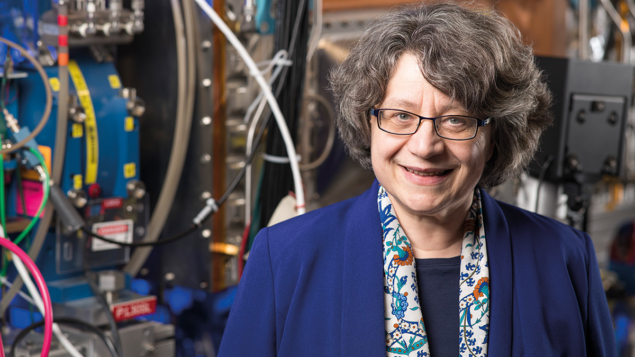Accelerator physicist Lia Merminga describes her career and priorities as new Fermilab director.

What first drew you to physics, and to accelerators in particular?
In school I liked and did well in science and math. I liked the feeling of certainty of math. There is an objective truth in math. And I was fascinated by the fact that I could use math to describe physical phenomena, to capture the complexity of the world in elegant mathematical equations. I also had an excellent, rigorous high-school physics teacher, whom I admired.
Accelerators offered the possibility of addressing fundamental challenges in (accelerator) physics and technology, and getting verifiable results in a reasonable amount of time to have a material impact. In addition, particle accelerators enable research and discovery in a vast range of scientific fields (such as particle and nuclear physics, X-ray and neutron science) and societal applications such as cancer treatment and radioisotope production.
What was your thesis topic?
My PhD thesis tackled experimentally, theoretically and via computer simulations the nonlinear dynamics of transverse particle oscillations in the former Tevatron collider at Fermilab, motivated by planning for the Superconducting Super Collider. Nonlinearities were introduced in the Tevatron by special sextupole magnets. In a series of experiments, we obtained accurate measurements of various phase–space features with sextupoles switched on. One of the features was the experimental demonstration of “nonlinear resonance islands” – protons captured on fixed points in phase space.
What have been the most rewarding and challenging aspects of your career so far?
There are many rewarding aspects of what I do. Seeing an audience, especially young people, who light up when I explain a fascinating concept. Pointing to something tangible that I contributed towards that will enable scientists to make discoveries in accelerator, particle or nuclear physics. Having conceived, worked on and advocated certain types of accelerators and seeing them realised. Predicting a behaviour of the particle beam, and verifying it in experiments. Also, troubleshooting a serious problem, and after days and nights of toil, finding the origin of or solution to the problem.
In terms of challenges, at Fermilab right now we are working on very complex and challenging projects like LBNF/DUNE. It involves more than 1400 international collaborators preparing and building a technically complex endeavour almost one mile underground. The mere scale of the operation is enormous but the pay-off is completing something unprecedented and enabling groundbreaking discoveries.
What are your goals as Fermilab director?
First and foremost, the completion of LBNF/DUNE to advance neutrino physics. Also, the completion of the remainder of the 2014 “P5” programmes, including the HL-LHC upgrades of the accelerator and CMS detector, and a new experiment at Fermilab called Mu2e. Looking to the future, when the next P5 report is completed, we will launch the next series of projects. Quantum technology is also a growing focus. Fermilab hosts one of five national quantum centres in addition to being a partner in a second one. We utilise our world-leading expertise in superconducting radiofrequency technology and instrumentation/control to advance quantum information technologies, as well as conducting unique dark-matter searches using this expertise.
Is being director different to what you imaged?
It takes a lot of hard work to build an excellent team, exceeding my initial projection. But equally our staff’s commitment, good will and dedication have also exceeded my expectations.
Which collider should follow the LHC, and what is the role of the US/Fermilab in realising such a project?
No matter which collider is chosen, there is still a lot of R&D required for any path concerning magnets, radiofrequency cavities and detectors. This R&D is crucial to multiple applications. I would advocate the development of these capabilities to push the state of the art for accelerators and detectors in the near future. Future colliders are an important component of the current Snowmass/P5 community planning exercise. Here, Fermilab is aligned with the previous P5 and is committed to following the next P5 recommendations.
How would you describe high-energy physics today compared to when you entered the field?
In the 1980s, the major building blocks of the Standard Model were largely in place, and the focus of the field was to experimentally verify many of its predictions. Today, the Standard Model is much more thoroughly tested, but there is evidence that it does not completely describe the whole picture.
The upcoming century promises a fascinating array of ground-breaking discoveries
A lot of present-day research is about physics beyond the Standard Model, including dark matter, dark energy and the question of matter–antimatter asymmetry in the universe. In parallel, technologies have advanced tremendously since the 1980s, enabling unprecedented precision, parameter reach and new discoveries. This applies to accelerators, telescopes, detectors and computing. The upcoming century promises a fascinating array of groundbreaking discoveries, all of which will fundamentally further our understanding of the universe.
What can be done to ensure that there are more female laboratory directors worldwide?
I think it is important to increase the pipeline, starting with efforts to attract young people in elementary and high school. We need to look at changing the cultural perspective that women can’t do STEM and get to the point where the entire culture is open-minded. We also need to change the make-up of the committees.
It is important to encourage females to take on leadership positions and then support and empower them with enlightened mentors. Once they develop their careers, we will have a much bigger pool for future lab directors. We must inspire and empower young girls and women to follow their dreams, and help them stay focused to succeed.





